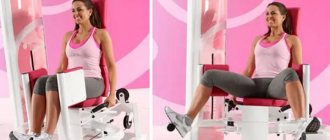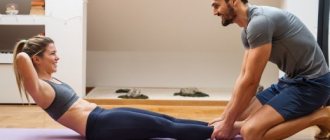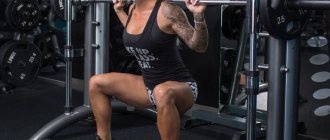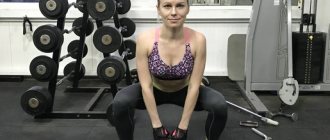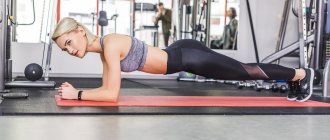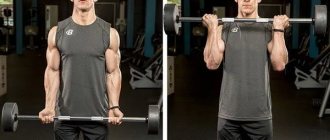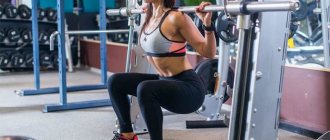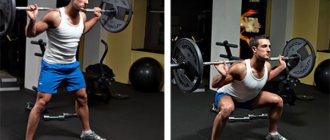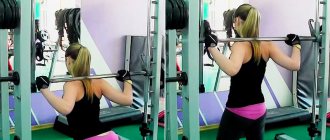What muscles can you pump up?
This type of training belongs to the Pull category and is an isolating exercise. The main goal is to strengthen the lower abdomen (abs). The main muscles involved when performing a supine leg raise are the following:
- internal pelvic muscles - iliopsoas;
- paired group of synergist muscles - pectoral, latissimus dorsi and gluteal;
- core muscles - stabilizers of the shoulders, abdomen, back and hips;
- rectus, medial, lateral and middle muscles of the thigh - quadriceps.
Additionally, read how to pump up your lower abs.
Tips for increasing efficiency
The main task when lifting legs while lying down is to learn to involve the abdominal muscles as much as possible in the movement and reduce the work of the iliopsoas muscles to a minimum.
To do this, in the starting position (legs down), you need to tense your abs, lifting your legs up only due to its strength. In this case, the abs should be constantly tense, without relaxing until the end of the exercise.
This technique is only possible at a slow and controlled pace.
As soon as you increase speed, inertia is added to the movement. The load on the abs is significantly reduced, but the participation of the iliopsoas muscles increases.
Another nuance is the degree of bending of the legs at the knees. When performing the leg lift exercise, the legs act as a natural weighting agent.
The smoother they are, the greater the amplitude of movement. Accordingly, the exercise is more difficult to perform. The rule works the other way around.
Execution technique
Consider the classic performance of lying leg raises:
- Lay out a gymnastics mat. Take a lying position on your back.
- Relax as much as possible. Place your hands under your lower back, palms down (you can place a small cushion under your lower back). Straighten your legs and close them together. This position is the starting point.
- As you exhale, raise both legs up, maintaining a 90-degree angle. Don't bend your knees. At the end point, linger for 1-2 seconds.
- As you inhale, slowly lower your lower limbs, trying not to touch the surface. The approximate distance from the floor to the heels should be 15-20 cm.
- Repeat the required number of approaches.
You can clearly see the technique of performing the exercise in the video below:
Secrets of the hanging leg raise and some recommendations
How to achieve 100% effect from the exercise? Experienced athletes talk about this and share their secrets:
- movements should always be performed cleanly, and you should not use the force of inertia during the exercise;
- at the top point of the exercise, you can not only linger for a few seconds, but also strain your abdominal muscles more diligently;
- Webbing or wrist straps are a very good solution for cases where your arms become unhooked on the bar. Also good when the athlete’s arms are not able to support his weight;
- For those who have already mastered this exercise for a long time, you can complicate the task and use weights. An excellent option would be dumbbells or weight plates between your feet.
What should those athletes do who are too overweight? In such cases, it is recommended to use not a horizontal bar, but special bars with a back.
Variations
In addition to the typical exercise, there are several variations. Each type of training is designed for people with different sports backgrounds (beginners, professional athletes and people undergoing rehabilitation measures):
1. Alternating leg raises for beginners. Lie down on a gymnastics mat. Straighten your back and legs. You can place your hands under the lower back or behind your head, clasping them together.
Movements: exhaling, raise one leg up to 45-60 degrees. Hold for 2 seconds. Lower your leg completely, touching the heel to the surface. As soon as the lower limb has taken the starting position, raise the opposite leg to the same angle. It is allowed to raise your head during the first few workouts, this will lighten the load a little.
2. Restorative exercise during the rehabilitation period (after surgery of the abdominal cavity, pelvic area, etc.). Lie down on the mat and completely relax. Straighten your back. Place the cushion under your head in the neck area. Keep your arms along your body. Your legs can be slightly bent at the knee. As you exhale, lift one leg, reaching an angle of 90 degrees. Hold for 2 seconds. As you inhale, return to the starting position. Repeat the same with the other limb. At the top point, try to gradually straighten your knee.
Before performing this exercise, you should consult a specialist. The doctor will prescribe the required load. Independent training is strictly prohibited. Leg lifts are contraindicated for pregnant women, since the main load falls on the lower abdomen, and an overly toned abs makes labor difficult.
3. Simultaneously raise your legs to an angle of 45-60 degrees. This exercise option is suitable for athletes with average physical fitness.
The initial position is identical to the classic version, i.e. horizontally. Raise your legs simultaneously to an angle of 45 or 60 degrees. At the end point, fixate for 2-3 seconds. As you inhale, return to the starting position without your heels touching the surface, maintaining a distance of 2-3 centimeters.
To simplify the exercise, full contact of the legs with the surface is allowed. This way the abs will rest, but this makes the workout less effective.
4. Weighted leg raises. If your abdominal muscles are developed and there is a need to increase the load, this variation is just for you. The technique is similar to the classical one. Only here it is necessary to attach a weighting agent to each lower limb or hold the dumbbell with your ankles. The weight of the weighting agent is selected for each athlete individually. Raising the legs is carried out to an angle of 45 or 60 degrees. Do not touch the floor with your feet, but leave a distance of 3-4 centimeters. Perform the required number of approaches and repetitions.
5. Lying on your stomach. Starting position: lie on your stomach. Stretch your arms forward. Close your legs together. As you exhale, alternately lift your lower limbs up. Try to fix your hips as much as possible. They are not allowed to be torn off the floor.
6. Leg raises while lying on your side. Lie on your side. Bend your arm at the elbow and rest on it. Legs straight. Technique: while exhaling, raise the lower limb as high as possible. Make sure that your leg does not bend at the knee joint. Perform the required number of times and change the position of your body, turning over to the other side.
Each leg lift option can be performed on training equipment or on a regular flat bench. The training does not require additional equipment, so it can easily be done at home.
Row of two dumbbells to the belt
The exercise resembles a standing bent-over barbell row. If the athlete already knows how to perform this deadlift, his task becomes easier. It is enough to select the weight of the dumbbells. The exercise allows you to work your back and does not overload your leg muscles. It is technically simpler than the bench-supported row option, as it requires almost no stretching.
When taking the starting position, it is important to grip so that the dumbbells do not hang on the athlete’s fingers. The grip should be the same on both sides
The athlete performs a slight forward bend, the universal starting point is a back tilt of 45 degrees. Then you need to bend your knees slightly so that you can stand comfortably and the load does not go into the hamstrings.
Next, the exercise is performed by bringing the shoulder blades together, that is, the start occurs by bringing the shoulder blade to the spine, then bringing the dumbbells to the belt. The elbows move in a plane parallel to the spine. It is not recommended to move the forearms perpendicular to the spinal column. The exercise is performed smoothly; the movement should not be jerky or jerky. The biceps are flexed just enough to bring the dumbbell to waist level.
This exercise can be performed in the “balance” version, that is, pulling one dumbbell at an angle towards the waist. This is a rarer option, it is used in strength sports to balance the work of the halves of the athlete’s back. This option is quite rare in bodybuilding, but it makes sense if an athlete has difficulty performing bent-over rows with a barbell and tends to extend too sharply as the barbell moves towards the waist.
Bent-over dumbbell row: technique
We recommend reading: How to quickly pump up m; muscles? Seven rules for building m; muscle mass
Dumbbell rows while lying on a bench
In this version, the backrest is installed so that the athlete can bring the dumbbells to the belt by tensing the latissimus dorsi muscles. The task becomes more difficult, since the legs only rest on the floor, and it will not be possible to pull the weight by slightly extending the back. Many people consider this row to be similar to the T-bar row, but this is not entirely true. The weight is distributed absolutely evenly, and therefore it turns out to develop the muscles harmoniously.
To perform this option, it is enough to tilt 30 degrees, lie on the bench with your stomach, grabbing dumbbells, and bring them to your waist, while simultaneously pulling your shoulder blades towards your spine and contracting your back muscles. The biceps should not pull the weight alone; the start occurs by bringing the shoulder blades together and contracting the lats. In this exercise, the rhomboid muscle also works, but the trapezius muscle is turned off due to emphasis and stabilization.
Errors
Insufficient body tilt. If the inclination is too high, you can transfer part of the load to the trapezius muscles. This will lead to the back not being worked enough. The same thing happens when an athlete actively “pulls” his body, performing small amplitude lifts;
Too much weight. If an athlete cannot retract their shoulder blades with any variation of the bent-over row, the weight is too heavy. In this case, the weight is “accelerated” by the biceps, which can lead to ligament injury;
Performing the exercise in jerks. Snatches throughout the entire amplitude are not only a traumatic activity, but also a technique in which the load goes into the body. When jerking, impact injuries are possible, as well as increased stress on the spine;
Raising your elbows to the sides. Some athletes perform swings instead of flyes, this leads to a transfer of load to the rear deltoid
Common mistakes
Beginning athletes, when performing the exercise of raising legs in a horizontal position, often make a number of mistakes. This not only affects the effectiveness of the workout, but also increases the risk of injury (remember that the spine and lower back are involved in the exercise).
Let's look at the main mistakes:
- Performing the exercise without a gymnastic mat. If you lie on a cold floor without equipment, and your body is hot during the exercise, the risk of lower back inflammation increases. Exercises should be performed in a well-ventilated area.
- Sudden rise and fall of legs. If the exercise is performed at an incorrect and fast pace, inconsistent muscle contraction occurs. To extinguish the resulting inertia, more strength and energy will be required. You simply won't be able to complete the required number of repetitions and will get tired quickly.
- Incorrect execution technique. Each lifting of the legs is accompanied by a delay at the top point for several seconds. This is necessary for the full effectiveness of the training.
- Continuing to perform the workout through strength and back pain. If at the first movements you experience pain in the back area, then you are advised to stop exercising and rest. If the pain recurs, reduce the load and contact an instructor.
- Incorrect leg angle. Don't try to prove to anyone or yourself that you have excellent stretching. The elevation angle is determined to the best of your ability. Otherwise, you risk getting a sprain.
- Workouts after meals. Remember, no physical exercise should begin immediately after eating. It is necessary to wait at least an hour to avoid nausea and vomiting.
- Initial exercises with increased loads. Start each workout with light exercises aimed at warming up the muscles. After this, do the easiest option (lifting your legs one at a time), gradually increasing the load.
What to replace
If we talk about abdominal exercises with raising legs or knees, then there are a lot of alternative options.
You can start with raising your knees to your chest while sitting, continuing with more complicated options - lifting your legs while standing or hanging. Remember that the degree of load is regulated by legs that are more bent or straighter at the knees.
You can also work the rectus abdominis muscle with the help of sit-ups. For example, crunches on an incline bench, crunches lying on the floor or in a machine.
Benefits of Exercise
The main advantages of raising legs in a horizontal position are the following indicators:
- effective development of abdominal muscles;
- strengthening the muscle mass of the abdominal region;
- developing the elasticity and strength of the hip flexors;
- development of core muscles;
- strengthening the gastrointestinal tract.
Useful tips
To get the maximum result from your workout, you should follow these simple recommendations:
- During the lifts, keep your legs straight, without spreading them to the sides;
- when returning to the starting position, do not touch the surface with your heels;
- follow the correct breathing technique - when exhaling - effort, when inhaling - return to the starting position;
- do not perform training with diseases of the spine (hernia, scoliosis, etc.);
- if the exercise is performed on a bench, make sure that the tailbone is not suspended;
- maintain the speed of movement - lowering slowly, rising quickly, but without abruptness.
Training frequency, volume and intensity
Each training option must be performed with a certain number of repetitions and approaches:
- Charging for warming up. Perform daily in the morning. The quantity is 10 times, 1-2 approaches.
- For newbies. Performed no more than 3 times a week. The required number of repetitions and approaches for each leg is 10 times, 1-2 approaches with a break of 1-2 minutes.
- Simultaneous rises to an angle of 45-60 degrees. Carry out no more than 3 times every seven days. The recommended number of repetitions is 10-15 times, approaches – 2-3 times. Rest – 3 minutes.
- Lifting with weights maximizes abdominal strength and promotes the formation of six-pack muscles. To do this, it is enough to train 2 times a week for 30 repetitions in 3-4 approaches.
The exercise is safe if the correct technique is followed. Movements should be smooth, without sharp rhythm. The lower back and spine must be kept in a stationary and extended position. This will prevent possible injuries and sprains.
